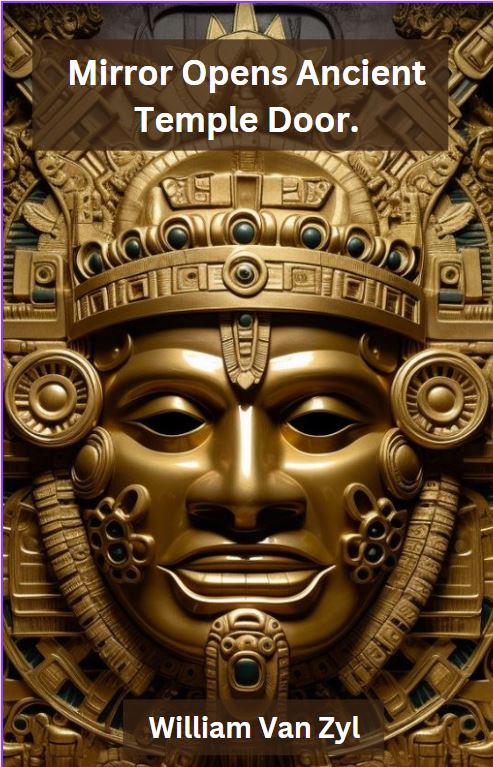
By William Van Zyl – Published in December 2023.
A tiny beam of light – entering from a slit in the roof of the cave – shines like a long shaft of enlightenment onto the rugged cave floor. Thousands specks of dust – hundreds of years asleep – are disturbed. They wake up. The ancient particles dance like other-wordly messengers in the bright beam.
Alexander studies the encoded map in the dimly lit cave, carefully tracing paths linked to symbols, with his fingers, revealing ancient South American shapes. The map points the way into the cave to a precious treasure. It guides them through the belly of the mysteriously sculptured temple.
As they move slowly ahead, within the cave’s darkness, another lone ray of sunlight creates an oblong shape on the floor, illuminating ancient symbols. The torch’s flame dances, casting licking tongue shadows on the decorated cave wall. It reveals an array of mystical wood carvings and rock sculptures.
Lara examines the symbols; she identifies one.
“That is the symbol for the Sun.”
They cautiously touch the protrusion around the Sun motif etched on the cave wall, tracing its edges.
“I think it could be a door,” suggests Alexander.
“How will we know that it is a door?”
“I am sure it is a door. It is the only way forward. There must be a way to open it.”
Suddenly, Lara remembers the mirrors they found earlier.
“The mirrors, where are the two mirrors?”
Alexander has the two mirrors in his backpack. He quickly slides his pack off his shoulders. He places his backpack on the ground and takes the mirrors out. Alexander hands one of the mirrors to Lara. She puts it under the strip of sunlight in front of them. She swivels the mirror, collecting most of the light. She carefully bounces the light off the mirror onto the wall. Their eyes follow the moving light spots on the cave walls. The Sun has an eye in its center. The eye senses two bright, reflected light beams, registering intelligent human activity.
“Use the other mirror too!”
The two light beams from the mirrors move closer to the Sun motif. Lara and Alexander align them on the Sun motif’s eye. Then, the two beams intersect; the cave groans with an eerie creak. The large door opens slowly, revealing a passage. Dust is now dancing wildly in the beams of light.

IMAGE: When the two mirrors reflected light from the cave roof onto the large Sun motif, the sun door lit up. A second motif – on the floor – also lit up. Credit: AI images. Prompt (Midjourney/Discord): ‘El Dorado theme. Two mirrors reflecting light onto a sun motif in a Columbian temple.”
Stunned, Alexander and Lara enter reluctantly. The floor is covered in hundreds of golden coins.
“Wow! This must be it!”
Alexander scoops up a handful of gold coins.
“This must be worth a fortune!”
Their attention turns to a sculpture against the wall, resembling an ancient god. Consulting the map, Lara realises that they have to make an offering.
“We must make a gold offering to get the mask.”
They move to the left of the sculpture. Then, they see a sizable antique iron and wood scale hanging askew.
“We must place gold coins on the scale to balance it,” suggests Alexander.
They carefully add gold coins to the empty scale bowl. The weight on the scale is slowly shifting.
“We have to balance it; be careful not to place too many coins,” cautions Lara.
When the scale is perfectly balanced, suddenly, a large cupboard opens to their right, revealing a magnificent golden mask. They are astonished.
“Wow! Look at that!”
“What a magical mask. It must be worth a fortune,” marvels Alexander.
“It must be solid gold. Be careful not to touch it. There could be a curse attached,” warns Lara.
“Check your intentions. Don’t be greedy! Your thoughts could destroy you.”
Now faced with the challenge of transporting the precious mask, they ponder the logistics, estimating the weight of their newfound wealth. The mask, a half-meter square, raises questions about their journey out of the temple cave. El Dorado conquered, they stand at the precipice of triumph, but the looming uncertainties beg the question—will they emerge unscathed, or will the curse of greed cast a shadow on their victory?
—————————————0—————————————-
IMAGE: Alexander and Lara discover the Golden Mask of El Dorado in the highly decorative cupboard. Credit: AI.
Table of Contents
Introduction:
I have produced a fictitious short story about how Lara and Alexander – the two archaeologists, found the elusive El Dorado temple and unearthed the Golden Mask.
In this resource – including the exciting legend of the elusive city of El Dorado – I look at the story, the gold, the treasure, the golden mask, and a modern-day escape room. I provide prompts for using technology – in the context of creating an El Dorado-themed escape room. Inspired by my visit to an escape room in Hamilton (NZ) in December 2023, I show how technology, like digital sensors, surveillance cameras, and more, could be used in escape rooms. I use a simple microprocessor – like the Arduino Uno – to show how this microprocessor could detect light and switch a rack and pinion – powered by an electric motor – to open a door—just like Lara and Alexander opened the door by reflecting the shaft of daylight from the cave roof onto the mirrors and the Sun motif. I use the Arduino, an LDR (light-dependent resistor), a relay, and an electric motor to show how a door in an escape room can be opened.
This resource could be helpful to teachers and students. The focus is integrating different subject areas for a lesson for high school students. For example, the brief is to design an El Dorado-themed escape room. I focus on technical aspects like art, design, and electronics (digital sensors, surveillance cameras, servos, racks and pinons, and more) to detect, switch and move doors.
The focus is also on how to create a light sensor (LDR – light-dependent resistor) to detect when a mirror reflects light that suddenly comes from a crack in the cave (an electrical light switched on after a symbolic puzzle is solved).
Improving and developing collaboration and solving real-life problems is another aspect I investigate. I look at the design of a board game—context: Escape room. We are developing creative and innovative skills of students and teachers.
I also touch on renewable systems: Installing solar panels, wind turbines, inverters, and 12 Volt (DC) batteries – on a micro-scale – to power an escape room or a model of an escape room.
Lastly, I provide links to cave ecosystems. I include the Waitomo Caves in New Zealand (famous glowworms).
See the ideas and concepts for possible lessons for students in this article. It is challenging to layer, embed, and integrate different subject areas into one or a set of lessons.
Possible subject areas:
Some great lesson ideas came to mind while at the escape rooms—title: The El Dorado legend – finding the elusive temple – and the golden mask. Teachers could ask students to design an escape room (Minecraft Education/freehand sketches/SketchUp). Include an electronic circuit – to open a door (reflect light in a dark temple – via a mirror – on a symbol). The light-dependent resistor could switch a motor on that opens a door – more clues to find the mask. A simple code (Arduino) with sensors could be included.
Many other opportunities – for different subject areas – are available. Here are some ideas:
- Art and design: Create the murals and reliefs for an escape room.
- Create symbols (codes): Symbiotic language based. For example, place unique-shaped blocks into specific holes in the correct sequence (small magnets built into the blocks).
- Geography & History: Include the story of the legend of El Dorado. Include a creative map-making challenge.
- Maths: Calculate the distance to travel from the map. Calculate the weight of gold to offer to the gods. Can you think of more calculation challenges?
- Electronics and coding: Produce and code the electronics for some of the special effects. For example, The opening of a small door when the light is deflected from the mirrors. It could house uniquely shaped objects in a special compartment. The use of an Arduino with specific code is a great choice.
- Creative writing (English and other languages): Capture the conversation between the two treasure hunters. Or, describe the ancient temple.
- Accounting: Work out the costs of creating a model/room. Calculate the interest the gold coins could have accumulated over 300 years (use today’s bank rates for bank deposits). Can you think of any other challenges?
- Architecture and design: Model the rooms in SketchUp or Minecraft Education. Why not consider an ancient Māori (New Zealand context) temple for an escape room?
- Sustainability, Biology, and Science: How caves are formed; analyse the ecosystems in caves. Is building an escape room in an actual cave a good idea? What do you think?
- Sustainable systems (off the grid): Design a simple renewable system in class – use the context of an escape room and build a small model. Include a 12 Volt battery. Show how the sun’s energy and wind energy are harvested. Use the multimeter in class and measure the current that flows from the solar panels. Also, measure the voltage of the 12-volt battery. Use the inverter (changes 12 volts to 5 volts or change it to 230 Volts (AC) and show how this system could be used to run an escape room off the grid. Could the escape rooms around the world be more sustainable? Could they install solar panels and small wind turbines? Where will they place the 12-volt batteries, regulators, and inverters?
- Board Game Design: In your groups, research escape room games. Design a concept for a board game. Use Minecraft, SketchUp, or an actual escape room as inspiration. You could also make soft pencils/ink/watercolours to make sketches of your escape room board and your ideas. Laminate your board game. You could have it professionally printed (and laminated) at a local printing shop. Play the game and improve it. Create a business plan: How to sell and market the product. Create spreadsheets – determine the profits per game (when sold).
- Māori (Te Reo): Create a similar story – with a legend from Māori culture/folklore. Change the El Dorado theme to a Māori theme. Explore Māori shapes, forms, patterns, and colours. Can you think of a Māori Temple? What could it look like? Find a cave system in New Zealand and create a temple in the cave system—an excellent opportunity to learn about caves and ecosystems. For example, the Waitomo Caves in the Waikato, NZ (glowworms). It also provides a chance to explore different temples from around the world.
- History and Social Sciences: Explore ancient temples from around the world.
- Food: What type of food would people eat during the ancient temple times? What type of food could Lara and Alexander have in their bags?
- Fashion: What type of clothes would people wear during the ancient temple times?
- Technology, Design & Architecture: What tools and materials would the people use to design and build the ancient temple?
- Science & Engineering: Explore the ancient temple’s building materials and structures. Can you think of any more areas and challenges? How could you create movement? Think about doors opening and more (keys, locks, levers, arms, rack and pinions, gears, rotating shafts and rods, weights, and more).
- Electronics and computer programming: Think a about electronic sensors. Consider using a Microbit or an Arduino Uno to create a circuit to detect light and switch a rack and pinion to open a door or compartment. See the rest of the article for some circuit and programming ideas!
- Mystical and supernatural concepts: How would the doors open by itself? After hundreds of years: How would the doors open all of a sudden? Any ideas?
Do you have any more ideas?
I have asked IA (images) to produce a Māori-inspired golden mask based on the El Dorado theme:
New Zealand context: Students could use any culture as inspiration. Here are Māori-inspired golden masks for a cool Māori Temple story.

IMAGES: 4 x Māori-inspired golden masks. Prompt Midjourney/Discord: Māori-inspired golden mask. Relate artwork to the El Dorado legend. Use Māori shape, form, colour, and pattern. Credit: AI




IMAGES: Golden mask ideas.
About El Dorado
IMAGE: The zipa, a mythical tribal chief of the native Muisca people, was said to cover his body in gold dust and, from his raft, offer treasures to the Guatavita goddess in the middle of the sacred lake. This old Muisca tradition became the origin of the legend of El Dorado. This Muisca raft figure is displayed in the Gold Museum, Bogotá, Colombia.
The legend of El Dorado is a tale of a mythical and legendary city of immense wealth, said to be located somewhere in the unexplored territories of South America. The story originated during the Spanish colonisation of the Americas in the 16th century. According to the legend, the rulers of the Muisca people in present-day Colombia engaged in a ritual where a new leader, or “gilded one,” covered himself in gold dust and dove into Lake Guatavita as an offering to the gods.
The allure of El Dorado captivated European explorers and treasure hunters, sparking numerous expeditions in search of the fabled city of gold. Conquistadors like Francisco Pizarro and Gonzalo Pizarro embarked on dangerous journeys into the Amazon rainforest to pursue this mythical wealth, but they still needed to find the legendary city.
Over time, El Dorado became more than a specific location; it symbolised the unattainable, representing the elusive quest for unimaginable riches. The legend of El Dorado has endured through centuries, influencing literature, art, and popular culture, while the actual city remains undiscovered, adding to its mystique.
The Golden Mask from El Dorado:
I have asked AI (Midjourney/Discord) to provide me with a golden mask – in typical Columbian cultural style.
PROMPT: The mystical El Dorado. Could you show some of the gold, treasures, coins and golden masks as prizes in the typical Columbian lost city? Focus on the golden mask.
Here is the result.
The mystical El Dorado mask. Could you show some gold, treasures, coins and golden masks as prizes in the typical Columbian lost city or temple? Focus on the golden mask as the ultimate prize.
IMAGE: One of the golden masks created by AI.
Map to El Dorado:
IMAGE: A creative map showing the way to El Dorado.
Albert Lin – a scientist and technologist – goes to Columbia with his high-tech equipment. He explores the legend of El Dorado with state-of-the-art technology.
Link to video (documentary): https://youtu.be/yYaBiPzSaPI?feature=shared National Geographic Explorer and scientist Albert Lin travels to Colombia to learn the truth behind the legends of El Dorado. See how Albert uses technology to explore the legend of Al Dorado.
Visit the website ‘The Escapist’ in Hamilton, New Zealand.
Look at the different escape rooms available online. Watch some videos on how to create an escape room.
Title: El Dorado
A couple of pictures from the escape room in Hamilton. Close to Centre Place (in the City Centre).
Credit: The Escapist (Hamilton, NZ): https://www.escapist.co.nz/el-dorado/
More escape rooms from THE ESCAPIST (New Zealand):
What is an Escape Room?
A room in which people are ‘locked in’ to play a game requiring them to solve a series of puzzles within a certain amount of time to accomplish a goal, typically finding the key to unlock the room.
An escape room, sometimes known as an escape game or puzzle room, is a themed challenge event where players collaborate to find clues, complete tasks, and solve various puzzles. The aim is to achieve a specific, time-bound goal – usually to escape from somewhere.
Escape Board Game:
Why not brainstorm ideas for an escape room board game?
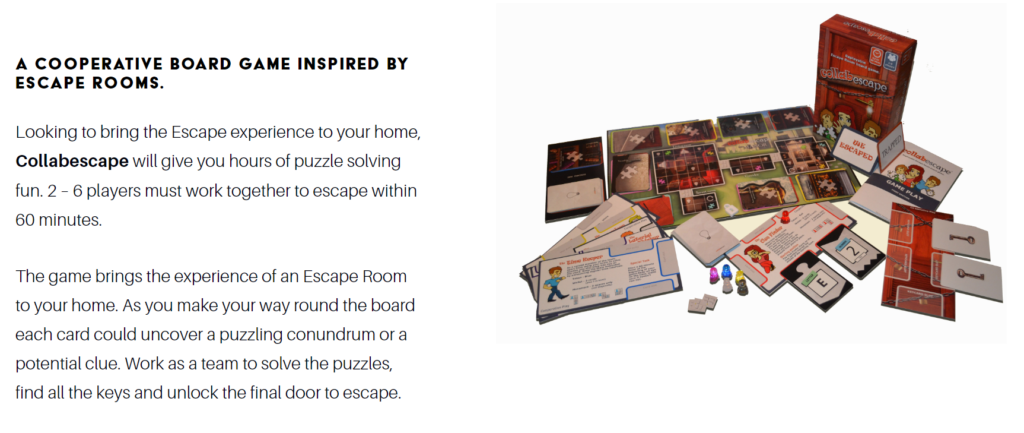
IMAGE: Collabescape Board Game. Link to website: https://www.collabescape.co.uk/
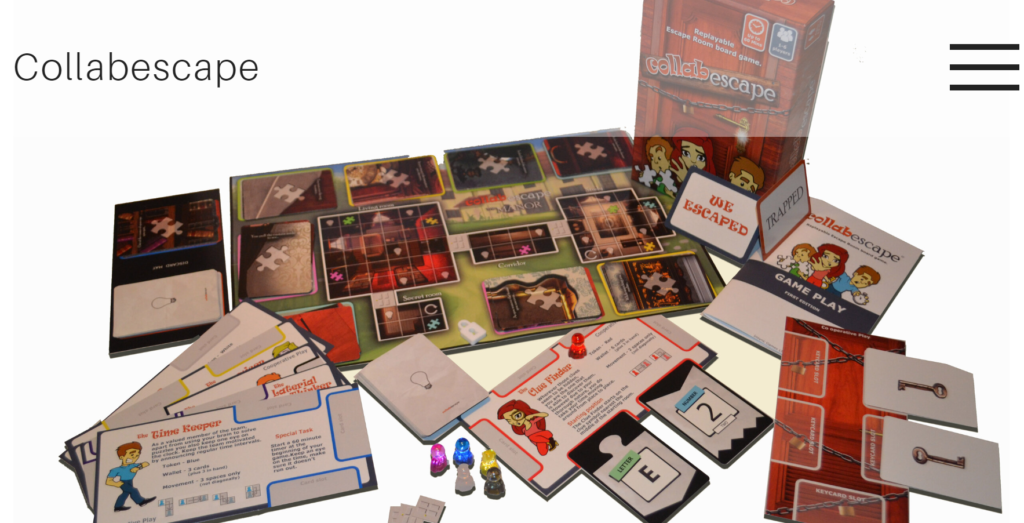
IMAGE: A closer look at the different components for the board game.
Lesson ideas for teachers and homeschoolers:
Why not create an Escape Room in Minecraft?
Video link: https://youtu.be/x1mh3gsRpcA?feature=shared
Here is a technical and practical challenge: Create a simple electronic system that can detect light (‘El Dorado’ mirror concept reflecting light on a LDR – the Sun motif) and a simple circuit that detects light and creates some movement. For example, a servo could open a small door in the temple.

IMAGE: Remember the mirrors that opened the ancient temple door? You can create something similar. This is similar to the electronics used in the EL DORADO escape room. Once the light is reflected from the mirrors onto the Sun (where the LDR sensor is located), an additional electrical motor – or servo – opens the small door to reveal the next cue. Learn how to set up a photoresistor (LDR) – a light-sensitive type of variable resistor – using Arduino’s Analog Input on a breadboard. Everything is in the Arduino Set. An LDR stands for a light-dependent resistor. The LDR works as follows: When you place your finger over the LDR, the sensor will sense that it is dark. There is no light on the LDR. Moving your finger over the sensor will switch on the LED (light). A relay and motor (or servo) could be included to provide movement (for example, door opening). The servo and electrical motor are not shown in this circuit.
Image from TinkerCad: Explore the sImple circuit embedded here in the workplane. Arduino at the bottom with a breadboard at the top.
Video:
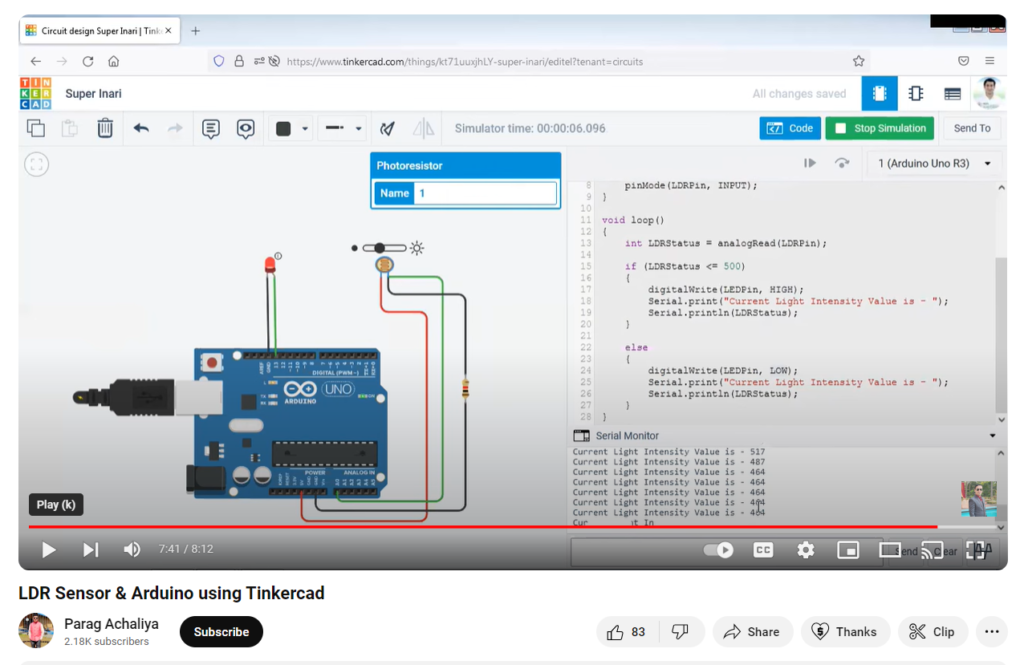
By clicking ‘Start Simulation’ and clicking on the photoresistor (brown oval with a squiggly line down the middle), then drag the brightness slider to adjust the simulated light input.
VIDEO: Step by step instructions on how to build the virtual circuit for the escape room: Arduino & LDR – light sensor.
https://www.tinkercad.com/projects/Light-Sensor-Photoresistor-Arduino-Tinkercad
Copy the code for this circuit (copied from TinkerCad): You can copy and paste any code from TinkerCad – easy!
// C++ code
//
int sensorValue = 0;
void setup()
{
pinMode(A0, INPUT);
Serial.begin(9600);
pinMode(9, OUTPUT);
}
void loop()
{
// read the value from the sensor
sensorValue = analogRead(A0);
// print the sensor reading so you know its range
Serial.println(sensorValue);
// map the sensor reading to a range for the LED
analogWrite(9, map(sensorValue, 0, 1023, 0, 255));
delay(100); // Wait for 100 millisecond(s)
}

IMAGE: This circuit has an Arduino (large blue board – far left), a resistor (bottom left), an LDR (bottom right), and a servo on the far right. The servo rotates up to 360 degrees. If you attach an extended arm to the servo horn and attach the other end to a small door, the circuit could open a small door (for example, opening a concealed door in an ancient temple – e.g. El Dorado context). Link to the article: https://canthoautomation.com/arduino-uno-control-servo-with-photoresistor/
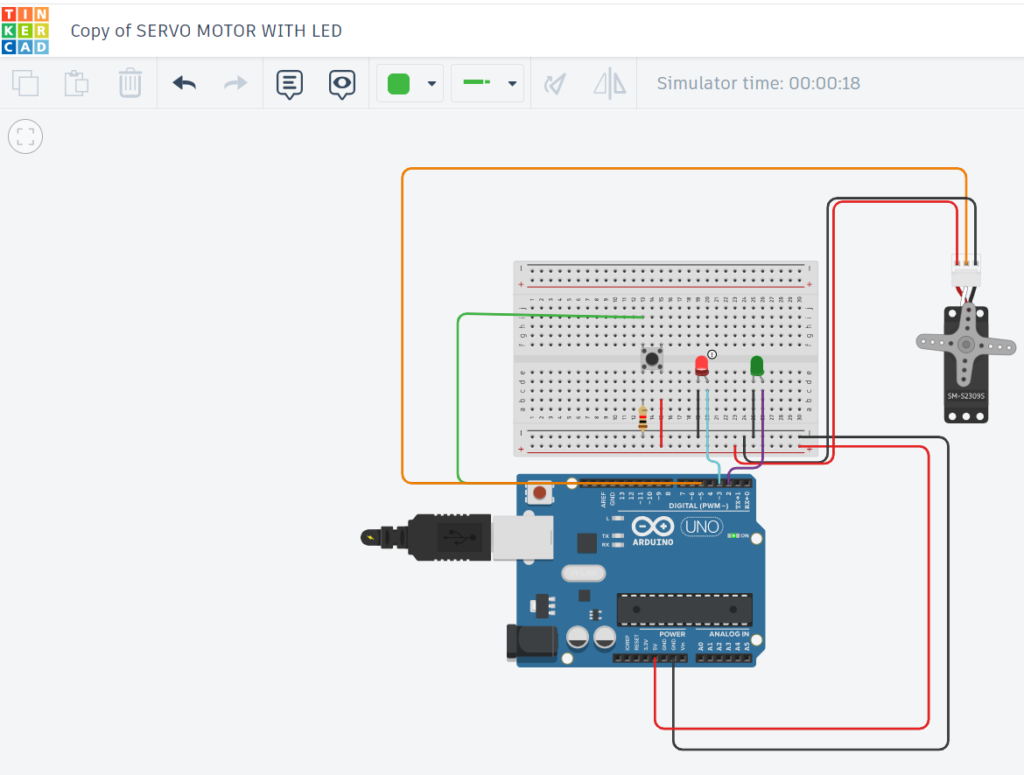
IMAGE: The complete simulation in TinkerCad. If you click on the small black button in the middle of the breadboard, the green LED lights up and the servo rotates. Link to the circuit in TinkerCad (search ‘TINKERCAD SERVO MOTOR WITH LED’): https://www.tinkercad.com/things/8HgyiYn0uNE-copy-of-servo-motor-with-led/editel?tenant=circuits
Rack and Pinion mechanism – alternative system to open a sliding door.

VIDEO: Showing how a rack and pinion mechanism works. A rack and pinion is another method to open a sliding door (El Dorado – opening a door context). https://youtu.be/tURgE38tdRs?feature=shared
For fun (AI): Rack and Pinion mechanism opening ancient temple door.

IMAGES: Ancient temple door ideas.
I love the close up detail of this ancient temple door:

IMAGE: AI-generated temple door.

IMAGE (AI): What a detailed ancient temple door! So cool.
For Students & Teachers – A basic lesson:
This is what the basic instructions could look like. As mentioned, you could develop these ideas by integrating different subject areas to the lesson. For example, creative writing: “Create your fictive story of El Dorado.” “Use your Minecraft Escape Room as prompts for your story.”
New Zealand context: Why not create a Māori story with a hidden treasure? Why not use Māori culture (New Zealand), or any other culture, for a similar story? Be creative and innovate! A great way to explore other cultures and their stories.
Concept lesson/instructions:
In your teams of 2 to 3.
- Research escape rooms.
- Find some exciting ideas for an escape room. Brainstorm!
- Design your escape room using pencil and paper. Create 2-D & 3-D sketches with annotations. Use these concept sketches to create your escape room. Use watercolours/acrylics/oil paint to render sketches.
- Use Minecraft education to create your escape room.
- Time to have fun! Time to play! Now, please invite your friends in class to test themselves in the escape room. Set a maximum time to complete or escape the room.
- SketchUp (free software): Design the basic layout of the escape room using SketchUp.
- Use TinkerCad – virtual circuits – to create a small door that will open when you reflect bright light onto the digital sensor (LDR). Use the virtual circuits in TinkerCad to guide you. Search GOOGLE: ‘TinkerCad light dependent resistor, LED, and Arduino’. Find a simple circuit. Open and tinker. You will have to create a free account on TinkerCad.
- Consider building the actual circuit if you have an Arduino set. The Arduino sets have all the components available in the box. You will need a computer, WiFi, and the Arduino set.
- Creative writing: Write a unique short story. Includes a different cultural context (800 words). Be innovative!
- Document all your work. As always, Screenshots, annotations and captions – in a Google Doc – share with the teacher.
Just for fun, I have asked AI to create an ‘Arduino Uno with a breadboard next to it. A light-dependent resistor, an LED, a servo, and jumper cables are in the circuit. The servo has a long arm connected to a small door. The servo rotates, and the long arm opens a small door.’

IMAGES: The four Arduino Uno images produced by AI. I think the first concept (top – left) is probably the best one to use as an example. However, there are no moving parts in these images – not very practical at all. Note it is just an idea. Prompt: Arduino Uno with breadboard next to it. A light-dependent resistor, an LED, a servo, and jumper cables are in the circuit. The servo has a long arm connected to a small door. The servo rotates, and the long arm opens a small door.

IMAGE: This circuit could be the best after scrutinising the AI-generated photos. The power supply for the Arduino – small black box on the far left – will change 230 Volt AC to 5 Volt DC (Arduino requires 5 volt DC to run). The large stack on the right (blue PC boards – representing the Arduino) as the microprocessor also houses 1 x white LED with a red wire (lit up in the image). Shown right at the top in this image. The 1 x LDR (light-dependent resistor) could be the sensor (black sensor just below the white LED). The sensor is just below the LED (lit up in the image) – black sensor. It looks like a microphone with a moveable support (bent at 90 degrees) to detect the change in light intensity. The servo is not shown. When it gets dark in the room, the sensor will switch the light (LED above the black sensor) on – via the Arduino. The value of generating AI circuits can provide creative ideas for housing components and the positioning of components. However, the sometimes detailed circuits could be more practical. Credit: Midjourney/Discord.
Renewable systems for an escape room:
Idea: Create a simple circuit to run an escape room model from a 12 Volt battery. An inverter can adapt the current from 12 to 5 Volt (USB – power an Arduino). It also provides 230 Volts (AC) for a home appliance (e.g. hairdryer). Teachers or homeschool parents could invest in a simple, renewable classroom system. All you will need is a small solar panel, a small wind turbine, a 12 Volt battery and an inverter.
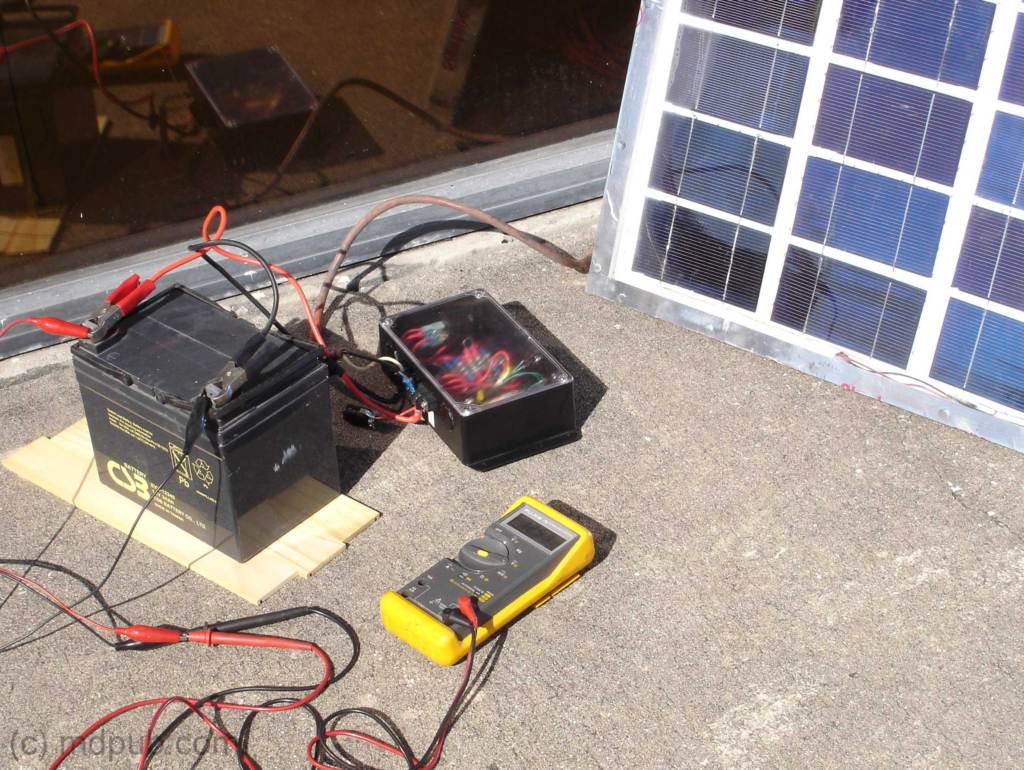
IMAGE: The picture shows a solar panel, a yellow multimeter (measures the voltage/current), a regulator (black translucent box), and a 12 Volt battery (far left -similar to a car battery). A small wind turbine could be added (not shown). Could this simple system be installed on the roof of the escape room building? The answer is yes. The biggest challenge is to get the cables and wires from the roof into the building. Credit: mdpub. https://mdpub.com/555Controller/images/panel1.jpg

IMAGE: The solar system I use in my classroom to explain how a solar system works. The inverter (silver coloured box on the right-middle), the Arduino with the breadboard (bottom-middle), the 12 Volt fan (black square with silver dot – far left), 12 Volt battery (black and red terminals attached to the black battery), solar panel (top – middle), regulator (small black box just to the right of the 12 Volt battery – white text on the box), and a 12 Volt LED light mounted on a piece of timber (shape of a spatula). This simple system shows how sunlight is stored in the 12 Volt battery. From the 12 Volt battery via the inverter – the 5 Volt USB connection runs the Arduino Uno. The inverter changes the 12 Volt to 5 Volt (USB port). The 12 Volt battery also powers the LED light and the fan. Credit: Author.
Interested in caves and their ecosystems?
Here are two articles on the Waitomo Caves in NZ. Don’t miss the glowworms!


Link:
The second article:


Link to the second article: https://fivehousepublishing.com/2021/10/14/sensors-maintaining-the-eco-equilibrium-of-sensitive-limestone-caves-in-new-zealand-stem-and-digital-technologies-programming-microprocessors-as-sensors-to-improve-cave-sustainability-microbit-an-3/
Interested in Māori resources on architecture, food, fashion, furniture, tools, worldview, AI, and more?
Search the blog posts: ‘Māori‘
Here are some examples of the many articles and resources available: Māori context (metalwork, woodwork, furniture, food, tools, worldview, placenta, AI, Modernist architecture [Le Corbusier – Villla Savoye and others], and much more).
Copyright © 2023 by William Van Zyl
Mirror Opens Ancient Temple Door.
All rights reserved. This eBook/article or any portion
thereof may not be reproduced or used in any manner
without the publisher’s permission, except for using brief quotations in a book review.
Published by Five House Publishing (New Zealand)
First Publishing, December 2023
More eBooks and articles are available at https://fivehousepublishing.com/
More about the author at http://williamvanzyl.com/